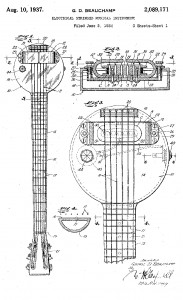🎸 The Electric Guitar Inventors Who Sparked Rock and Roll
Think of a rock and roll band and what’s the first image that jumps to mind? A howling electric guitar, maybe? Maybe a bassist pounding out the beat to match? Yeah, us too.
From stage-smashing solos to that unmistakable fuzzy edge, the electric guitar is the sound of rock and roll. But the story of how this iconic instrument came to life isn’t just one of invention—it’s one of rebellion, experimentation, and a little bit of garage-shop magic. Meet the unsung heroes who turned up the volume and helped invent the future of music.
⚡ Guitars Go Electric

Guitars have been strummed for centuries—plucked in parlors, picked on porches, and played in smoky cafés. But back in the early 20th century, acoustic guitars just couldn’t cut it in a band. They got drowned out by horns, pianos, and drums.
Enter George Beauchamp, a Hawaiian-style guitarist who wanted to be heard. In 1931, he teamed up with engineer Adolph Rickenbacker to create the first electromagnetic pickup. They mounted it to a metal Hawaiian lap steel guitar, known affectionately as the “frying pan” for its round shape.
The pickup worked like magic—it sensed the vibration of the strings and turned it into an electric signal that could be amplified. No feedback, no background noise, just pure tone. And just like that, the electric guitar was born.
🎸 Beauchamp and Rickenbacker’s invention would change music forever—and make “Rickenbacker” a household name in guitar circles.
🎷 From Lap Steel to Lead Guitar: Les Paul
Then came Les Paul, the jazz and blues maestro who wasn’t satisfied with the frying pan. Around 1940, Les built what he lovingly called “The Log”—a 4×4 slab of wood with strings and electronics. It looked like a lumberyard experiment (and kind of was), but it sounded fantastic.
Later, he added parts of a sawn-off Epiphone body to make it look more like a traditional guitar. And though it took some convincing, Gibson eventually partnered with Les, creating the iconic Gibson Les Paul. It became a favorite of everyone from Jimmy Page to Slash.
🎶 Les wasn’t just a player—he was a sound engineer, inventor, and musical visionary. He also pioneered multitrack recording. We owe this guy a lot.
🎛️ Enter Leo Fender: The Engineer Who Rocked

On the other coast, Leo Fender was doing his own tinkering. Unlike Les, Leo wasn’t a guitarist—he was a radio repairman. But he had a knack for making things better, and in 1950, he unveiled the Fender Telecaster, the first mass-produced solid body electric guitar.
Then came the 1954 Stratocaster—with three pickups, a tremolo bar, and that now-iconic contoured body. It screamed rock and roll.
But Fender wasn’t done. He also invented the Fender Precision Bass, replacing the old-school upright bass with a portable, thumping, low-end monster. It revolutionized rhythm sections everywhere.
🕺 Fender gave the world tools to build a new kind of band. His guitars didn’t just sing—they shouted.
🎸 How the Electric Guitar Reshaped Rock
Before electrics took over, most bands leaned on saxophones or pianos. The guitar was more of a rhythm instrument—a sidekick, not a star.
But with amps turned up and pickups humming, the electric guitar leapt into the spotlight. It could lead, cry, growl, and dance. Bands like Buddy Holly and the Crickets, Chuck Berry, Elvis, and The Ventures put guitars front and center, and rock hasn’t looked back since.
🎤 By the mid-1950s, the rock band lineup had transformed into what we recognize today: lead guitar, bass, drums, and attitude.
🏆 Rock Hall Honors
Both Leo Fender and Les Paul are enshrined in the Rock and Roll Hall of Fame, not as performers but as inventors. Without their vision—and a few lucky accidents—there would be no classic guitar riff in Johnny B. Goode, no power chords in My Generation, and no face-melting solos from Stairway to Heaven.
🎥 Want to See How It All Looked?
Here’s a short video showing vintage electric guitars from the 1950s:
🎬 Watch: “History of the Electric Guitar”
So next time you hear that first crunch of a power chord or a wah-wah solo that gives you chills, tip your hat to the guys in lab coats and garages who made it all possible. They didn’t just invent an instrument—they invented a movement.